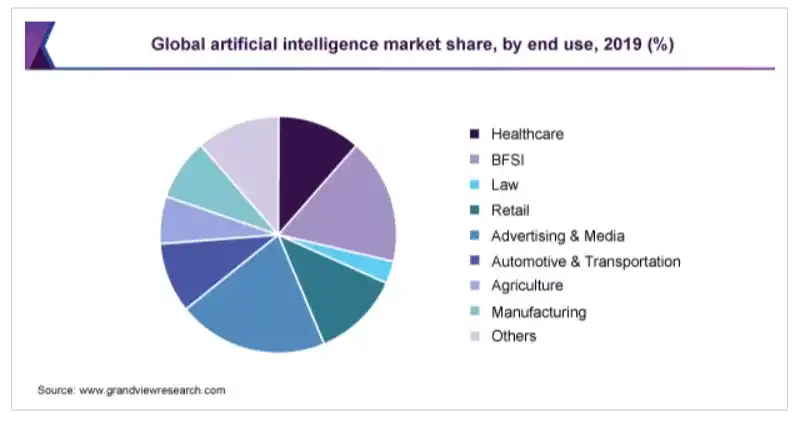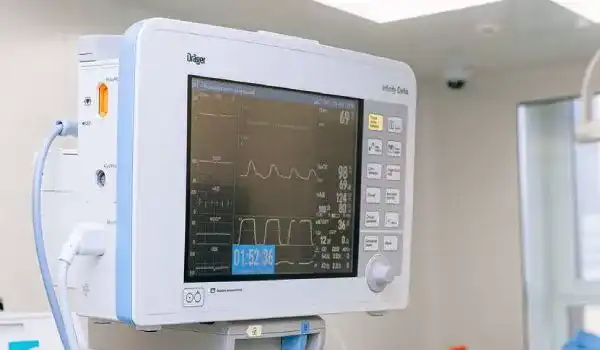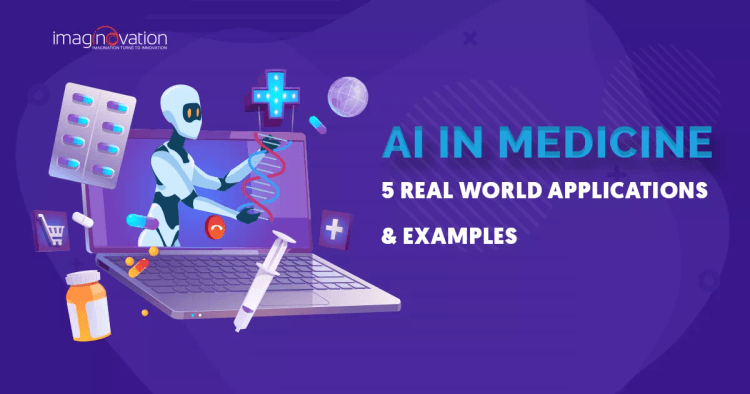There’s no denying that Artificial Intelligence (AI) has become ubiquitous. It is becoming increasingly sophisticated at doing what humans do efficiently – learn, reason, and apply logic.
Like in many other business sectors, AI has a vast potential to improve the medical industry.
You may already be using a few AI-enabled wearables to keep track of your health – FitBit, Smartwatch, or a Smart belt.
If you look closely, you will find many great examples of AI in medicine. It is gradually becoming part of our healthcare ecosystem.
In this blog, we discuss the real-world application and use cases of AI in the medical field.
AI in Medicine: The Market Trends
Artificial Intelligence is set to play a prominent role in medicine & healthcare.
There are many reasons for this, such as:
- Advances in computing power,
- Learning algorithms,
- Availability of massive data from medical records, and
- Wearable health devices.
The healthcare market for Artificial Intelligence is increasing day by day, and the market trends look anything but promising.
Market Value
According to reports, AI in the global healthcare market value is projected to grow from 3.14 billion USD in 2019 to 23.85 billion USD by 2025.
It is expected to grow at a CAGR (Compound Annual Growth Rate) of 40.15% during the forecast period from 2020 to 2025.
End-Use Insight
The Advertising and media segment led the AI market in 2019 and accounted for more than 20% share of the global revenue. The healthcare sector is projected to gain a leading share in the AI market by the year 2027. (Source)

Real-world Applications of AI in Medicine
With a high volume of available data, AI is poised to be the engine that drives transformation across the medicine sector.
With Artificial Intelligence, Learning Algorithms are becoming more accurate and precise as they allow us, humans, to gain insights into diagnostics, treatments, and care processes.
Here are some real-world applications of Artificial Intelligence in medicine that can benefit both patients and physicians.
1. Disease Diagnosis
The correct diagnosis is the key to a successful treatment. In the case of misdiagnosis, a lot can go wrong. Therefore, getting it right is extremely important, but it is not always easy.
Applying Artificial Intelligence to healthcare diagnosis is providing many benefits to the medical industry.
AI-based software can assess whether a patient has a particular disease even before many evident symptoms appear. And, in the majority of the cases, these predictions are accurate.
AI makes diagnostics cheaper and more accessible.
Machine Learning – especially Deep Learning algorithms are used quite a lot these days in automatically diagnosing diseases.

Machine Learning in Disease Diagnosis
Well, ML – Machine Learning algorithms learn to see patterns similar to the way doctors see them. A significant difference here is that algorithms need many concrete examples to learn from. And these examples are digitized because machines cannot read between the lines in textbooks.
So, Machine Learning is specifically helpful in areas where the diagnostic information that a doctor examines is already digitized. For example, images from MRI machines, CT scanners, and X-rays contain large amounts of complex data that is difficult and time-consuming for humans to evaluate.
Machine Learning can be handy in:
- Detecting brain tumor or lung cancer based on CT scans
- Assessing the risk of sudden cardiac arrest or other heart diseases based on ECG and cardiac MRI images
- Classifying skin lesions in skin images
- Finding traces of diabetic retinopathy in eye images
Why Use AI When Physicians Can Do Everything Mentioned Above?
Now you might be wondering why go in for AI when there are physicians to do it?
Artificial intelligence techniques like ML are like the second pair of eyes that can evaluate patient health based on the knowledge extracted from available data.
There is plenty of useful data (CT, MRI, genomics, patient’s records, and handwritten files) available in the cases mentioned above. And with all this data, machine learning algorithms are becoming just as efficient as the diagnostics by an expert.
Machine learning algorithms stand out because it’s able to draw conclusions much faster and the models can be replicated at low costs all over the world.
Oh, so does that mean AI will replace the doctors sometime soon?
No.
It is quite unlikely that AI will replace physicians and doctors soon. AI will be used instead to highlight potentially malignant tumors or life-threatening cardiac patterns of patients. This will allow the doctors to focus on the interpretation of highlighted signals.
2. Faster Drug Development
Developing a drug is an increasingly competitive and expensive medical business. Even with the technological progress, the cost of creating a new drug increases every few years. AI can play a significant role here.
Leading medical and pharmaceutical companies are using AI to reduce their R&D costs and avoid costly errors.
Many of the analytical processes in drug development can be made more efficient with Machine Learning. This has the potential to shave off millions in investments.
By 2026, the health AI applications can potentially create 150 billion USD annual savings for the United States healthcare economy.
Drug development is divided into four stages.
- Stage 1 – Target identification for intervention
- Stage 2 – Discovering the drug candidates
- Stage 3 – Speeding up of clinical trials
- Stage 4 – Finding Biomarkers for diagnosing the disease
You’ll be surprised to know that AI is already being used successfully in all these stages. Let’s go through each one of them and understand what these stages do.
Stage 1 – Target identification for intervention
The first step in developing a drug should be, understanding the biological origin of a disease and its resistance mechanisms. Then you must be able to identify suitable targets (typically proteins) for treating the disease.
Although with high-throughput techniques, like short hairpin RNA (shRNA) screening and deep sequencing, huge data is made available to discover possible target pathways.
But with traditional methods, it’s still challenging to integrate the big number and variety of data sources – and then look for the relevant patterns.
Machine learning algorithms here quickly analyze all the available data and learn to identify good target proteins automatically.
Stage 2 – Discovering the drug candidates
The next step involves finding a compound that can interact with the identified target molecule in the required way.
This involves screening a vast number of potential compounds for their effect on the target (affinity). These compounds could be either natural, synthetic, or bio-engineered.
However, the current system can create inaccurate and inadequate suggestions. So, in reality, it takes a very long time to finalize the best drug candidates.
Machine Learning algorithms help here: They learn to predict a molecule’s suitability based on structural fingerprints and molecular descriptors. Then they go through millions of potential molecules and filter them all to the best options – those with minimal side effects.
This, therefore, ends up saving much time in drug design.
Stage 3 – Speeding up of clinical trials
It’s not easy to find suitable candidates for clinical trials. If you select the wrong candidates, it will prolong the trial – costing both time and resources.
Machine learning can speed up the process of clinical trials. It can identify suitable candidates and ensure there’s a proper distribution for groups of trial participants. The algorithm can be trained to separate good candidates from the bad.
AI technology does three things for the clinical trial process: Makes it faster, reliable, and more secure.
They can also alert by giving an early warning for a clinical trial that is not producing conclusive results – thus allowing the researchers to intervene earlier by saving the drug’s development.
Stage 4 – Finding Biomarkers for diagnosing the disease
Patient treatment for a disease is possible only when you’re sure of the diagnosis.
Biomarkers are molecules found in bodily fluids like human blood that conclude whether or not a patient has a disease. They can also be used to track disease progression.
But discovering suitable Biomarkers for a disease is not easy. It’s an expensive and time-consuming process that involves screening thousands of potential molecule candidates.
AI automates a large portion of the manual work here and, in turn, speeds up the process.
The algorithms can classify molecules into good and bad candidates – which helps the experts analyze the best prospects.
Biomarkers are used to identify:
- The presence of disease at the earliest – diagnostic biomarker
- The risk of a patient developing a disease – risk biomarker
- The probable progress of a disease – prognostic biomarker
- Whether the patient will respond to a drug or not – predictive biomarker
For example, in 2017, UK-based AstraZeneca collaborated with biopharma company Berg and used AI to find biomarkers and drugs for neurological disease.
3. Virtual Nursing Assistant

If given an option, many of us would opt not to make an avoidable visit to hospitals. But is it possible?
With virtual nursing assistants, this seems like a possibility.
Virtual nursing assistants reduce unnecessary hospital visits and further lessen the burden on medical professionals.
An AI-powered virtual nursing assistant can offer a personalized experience to the patients. It can help identify illness based on symptoms, monitor health status, schedule doctor’s appointments, and do many more things. It can prevent any chronic situation from getting worse.
Virtual assistants are in hot trend these days. Hospitals and medical professionals are using them to increase patient engagement and improve their self-management skills.
4. Provide Personalized Treatment
Different patients respond differently to drugs and treatment schedules. With personalized treatment options, there’s an enormous potential to increase patients’ lifespan.
Machine Learning is used to provide personalized treatment.
How?
It can help discover the characteristics that indicate a patient will have a specific response to a particular treatment. It can predict a patient’s probable response to a particular treatment.
But how does the ML algorithm learn this?
The system learns this by cross-referencing data of similar patients and comparing their treatments and outcomes. This is very helpful for doctors to design the right treatment plan for the patient.
5. Enhance Gene Editing

What’s more, AI is also being used in genomic research.
Machine Learning techniques are continuing to find their ways into genome sequencing and annotation, and other things. And that’s not the end.
It’s also being used in genome-based diagnostics.
And if you think AI can’t change our genes, you’ll have to think again.
Clustered Regularly Interspaced Short Palindromic Repeats (CRISPR), especially the CRISPR-Cas9 system for gene editing, has provided a big step forward in our ability to edit DNA in a cost-effective and precise manner. Besides these, we also have TALENs and ZFNs to contribute to gene editing.
AI is already helping us in many more ways. But this is just the beginning.
The more we can digitize and unify our medical data, the more we will be able to use AI to make further accurate and cost-effective decisions in complex analytical processes.
The Future of AI in Medicine in 2021 and beyond
Artificial Intelligence has much potential, and to realize that fully, we would need combined efforts from experts in Medicine, Computer Science, Mathematics, and many more.
1. Exploring AI’s Potential in Specific Areas
Artificial Intelligence can transform medicine in the following areas:
- Reducing medical errors
Medical errors lead to misdiagnosis. For example, in breast cancer, false-negative mammogram reports can delay treatment for many women. AI is used extensively to detect any such abnormalities that human eyes cannot see.
- Making healthcare human again
This can be AI’s most beneficial contribution to healthcare. The unnecessary work involved in data entry can be avoided. The doctor can rather deal with the patient with compassion without getting into data entry.
- Getting diagnosed with a picture’s help
The future can be an age of “medical selfie” to get diagnosed only with a selfie.
2. Making data accessible to everyone
Do you think it’s sufficient if we only build medical AI products?
No. What’s more important is to get these products out to people’s access.
Let’s take the example of American-trained AI models for lung diseases that don’t include TB in their labeling. TB is a problem in developing world countries, but not so in America, so scans of TB are not found in the training dataset.
But, AI must work everywhere for everyone. Adding images of tuberculosis to the datasets would help generalize and democratize AI to other parts of the world.
3. IoMT – Internet of Medical Things
We will need many more devices and mobile apps that will play a critical role in tracking and preventing chronic illnesses for patients and their doctors.
AI’s growing potential to synergize with other healthcare technologies can thus present many possibilities in the industry.
Build Smart AI-Powered Medical Platform with Imaginovation
Are you willing to transform your healthcare and medical business with AI? If yes, get in touch with us.
We are an award-winning technology company with vast experience in creating AI-based applications. Let’s talk.
Ready to build an app, but not sure where to start?
We've got you covered. Click the button below to get started.





